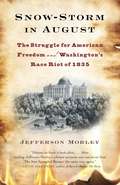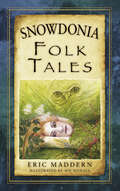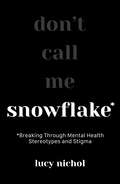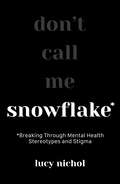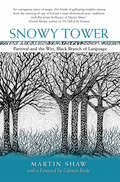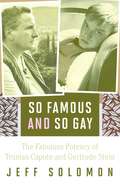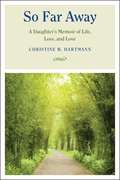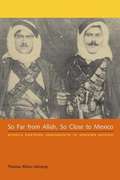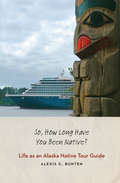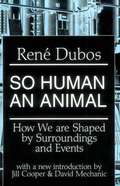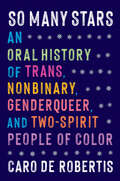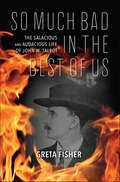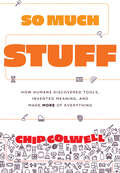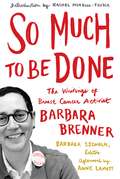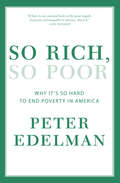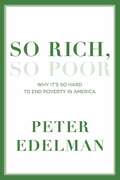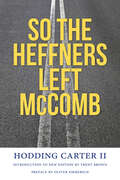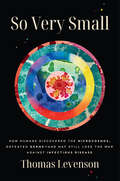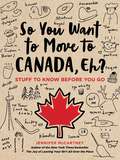- Table View
- List View
Snow-Storm in August: Washington City, Francis Scott Key, and the Forgotten Race Riot of 1835
by Jefferson MorleyA gripping narrative history of the explosive events that drew together Francis Scott Key, Andrew Jackson, and an 18-year-old slave on trial for attempted murder. In 1835, the city of Washington pulsed with change. As newly freed African Americans from the South poured in, free blacks outnumbered slaves for the first time. Radical notions of abolishing slavery circulated on the city's streets, and white residents were forced to confront new ideas of what the nation's future might look like.On the night of August 4th, Arthur Bowen, an eighteen-year-old slave, stumbled into the bedroom where his owner, Anna Thornton, slept. He had an ax in the crook of his arm. An alarm was raised, and he ran away. Word of the incident spread rapidly, and within days, Washington's first race riot exploded, as whites fearing a slave rebellion attacked the property of the free blacks. Residents dubbed the event the "Snow-Storm," in reference to the central role of Beverly Snow, a flamboyant former slave turned successful restaurateur, who became the target of the mob's rage.In the wake of the riot came two sensational criminal trials that gripped the city. Prosecuting both cases was none other than Francis Scott Key, a politically ambitious attorney famous for writing the lyrics to "The Star-Spangled Banner," who few now remember served as the city's district attorney for eight years. Key defended slavery until the twilight's last gleaming, and pandered to racial fears by seeking capital punishment for Arthur Bowen. But in a surprise twist his prosecution was thwarted by Arthur's ostensible victim, Anna Thornton, a respected socialite who sought the help of President Andrew Jackson.Ranging beyond the familiar confines of the White House and the Capitol, Snow-Storm in August delivers readers into an unknown chapter of American history with a textured and absorbing account of the racial secrets and contradictions that coursed beneath the freewheeling capital of a rising world power."Snow-Storm in August is the sort of book I most love to read: history so fresh it feels alive, yet introducing me to a time and place that I had little known or utterly misunderstood. After reading Jefferson Morley's vibrant account, one can never hear 'The Star-Spangled Banner' the same way again."--David Maraniss, author of Barack Obama: The StoryFrom the Hardcover edition.
Snowdonia Folk Tales (Folk Tales)
by Eric Maddern Sue MynallNorth-west Wales – Old Gwynedd – is one of the most mythic parts of Britain and has some stories whose roots go back more than 2,000 years. Some, like ‘Blodeuwedd, the Woman of Flowers’, feature in the Mabinogion. Others like the story of ‘Merlin and the Dragons’ were written by Geoffrey of Monmouth in the first bestseller of all time (after the Bible), the History of the Kings of Britain. Eric Maddern retells these ancient classics in a fresh, contemporary style. He also includes lesser-known tales from Ynys Môn (the island known as Mâm Cymru, ‘Mother of Wales’), once the heartland of the Druids (like ‘The Story of the Druid Prince’) and the majestic mountains of Snowdonia (Marged Ferch Ifan, ‘the Welsh Amazon’).
Snowflake: Breaking Through Mental Health Stereotypes and Stigma
by Lucy Nichol'Sensitively and seriously exploring mental health stereotypes' StylistThis is NOT a book of rules or statistics. It will NOT tell you what you can and can't say to someone with a mental health problem – or to anyone for that matter. It WILL increase your understanding and empower you to stop stigma in its tracks.Take a deep-dive into some of the most harmful mental health stereotypes with mental health advocate and author Lucy Nichol. Lucy exposes 10 of the most harmful mental health stereotypes and explores the impact of social media, the power of the press and how mental health is represented in popular culture. With the help of experts and the voices of those affected by these harmful perspectives, Lucy makes a case for how we can dismantle stigma once and for all.Foreword by Sue Baker OBE. Contributors include: Natasha Devon MBE, Jonny Benjamin MBE, Hope Virgo, Cara Lisette and Dr Craig Malkin.
Snowflake: Breaking Through Mental Health Stereotypes and Stigma
by Lucy Nichol'Sensitively and seriously explores mental health stereotypes' StylistThis is NOT a book of rules or statistics.It will NOT tell you what you can and can’t say to someone with a mental health problem – or to anyone for that matter.It WILL increase your understanding and empower you to stop stigma in its tracks.Take a deep-dive into some of the most harmful mental health stereotypes with mental health advocate and author Lucy Nichol.Lucy exposes 10 of the most harmful mental health stereotypes and explores the impact of social media, the power of the press and how mental health is represented in popular culture.With the help of experts and the voices of those affected by these harmful perspectives, Lucy makes a case for how we can dismantle stigma once and for all.Foreword by Sue Baker OBE. Contributors include: Natasha Devon MBE, Jonny Benjamin MBE, Hope Virgo, Cara Lisette and Dr Craig Malkin.
Snowflake: Breaking Through Mental Health Stereotypes and Stigma
by Lucy Nichol'Sensitively and seriously explores mental health stereotypes' StylistThis is NOT a book of rules or statistics.It will NOT tell you what you can and can’t say to someone with a mental health problem – or to anyone for that matter.It WILL increase your understanding and empower you to stop stigma in its tracks.Take a deep-dive into some of the most harmful mental health stereotypes with mental health advocate and author Lucy Nichol.Lucy exposes 10 of the most harmful mental health stereotypes and explores the impact of social media, the power of the press and how mental health is represented in popular culture.With the help of experts and the voices of those affected by these harmful perspectives, Lucy makes a case for how we can dismantle stigma once and for all.Foreword by Sue Baker OBE. Contributors include: Natasha Devon MBE, Jonny Benjamin MBE, Hope Virgo, Cara Lisette and Dr Craig Malkin.
Snowy Tower
by Coleman Barks Martin ShawIn Snowy Tower, Dr. Martin Shaw continues his trilogy of works on the relationship between myth, wilderness, and a culture of wildness. In this second book, he gives a telling of the Grail epic Parzival. Claiming it as a great trickster story of medieval Europe, he offers a deft and erudite commentary, with topics ranging from climate change and the soul to the discipline of erotic consciousness, from the hallucination of empire to a revisioning of the dark speech of the ancient bards. Ingrained in the very syntax of Snowy Tower is an invocation of what Shaw calls 'wild mythologies' -- stories that are more than just human allegory, that seem to brush the winged thinking of owl, stream, and open moor. This daring work offers a connection to the genius of the margins; that the big questions of today will not be solved by big answers, but by the myriad of associations that both myth and wilderness offer.
So Famous and So Gay: The Fabulous Potency of Truman Capote and Gertrude Stein
by Jeff SolomonGertrude Stein (1874–1946) and Truman Capote (1924–1984) should not have been famous. They made their names between the Oscar Wilde trial and Stonewall, when homosexuality meant criminality and perversion. And yet both Stein and Capote, openly and exclusively gay, built their outsize reputations on works that directly featured homosexuality and a queer aesthetic. How did these writers become mass-market celebrities while other gay public figures were closeted or censored? And what did their fame mean for queer writers and readers, and for the culture in general? Jeff Solomon explores these questions in So Famous and So Gay.Celebrating lesbian partnership, The Autobiography of Alice B. Toklas was published in 1933 and rocketed Stein, the Jewish lesbian intellectual avant-garde American expatriate, to international stardom and a mass-market readership. Fifteen years later, when Capote published Other Voices, Other Rooms, a novel of explicit homosexual sex and love, his fame itself became famous. Through original archival research, Solomon traces the construction and impact of the writers&’ public personae from a gay-affirmative perspective. He historically situates author photos, celebrity gossip, and other ephemera to explain how Stein and Capote expressed homosexuality and negotiated homophobia through the fleeting depiction of what could not be directly written—maneuvers that other gay writers such as Gore Vidal, Tennessee Williams, and James Baldwin could not manage at the time. Finally So Famous and So Gay reveals what Capote&’s and Stein&’s debuts, Other Voices, Other Rooms and Three Lives, held for queer readers in terms of gay identity and psychology—and for gay authors who wrote in their wake.
So Far Away: A Daughter's Memoir of Life, Loss, and Love
by Christine W. HartmannChristine Hartmann's mother valued control above all else, yet one event appeared beyond her command: the timing of her own death. Not to be denied there either, two decades in advance Irmgard Hartmann chose the date on which to end her life. And her next step was to tell her daughter all about it. For twenty years, Irmgard maintained an unwavering goal, to commit suicide at age seventy. She managed her chronic hypertension, stayed healthy and active, and lived life to the fullest. Meanwhile, Christine fought desperately against the decision. When Irmgard wouldn't listen, the only way to remain part of her life was for Christine to swallow her mother's plans--hook, line, and sinker.Christine's father, as it turned out, prepared too slowly for old age. Before he had made any decision, fate disabled him through a series of strokes. Confined to a nursing home, severely impaired by dementia and frustrated by his circumstances, his life epitomized the predicament her mother wanted to avoid. So Far Away gives us an intimate view of a person interacting with and reacting to her parents at the ends of their lives. In a richly detailed, poignant story of family members' separate yet interwoven journeys, it underscores the complexities and opportunities that life presents each one of us.
So Far Away: A Daughter's Memoir of Life, Loss, and Love
by Christine W. HartmannChristine Hartmann's mother valued control above all else, yet one event appeared beyond her command: the timing of her own death. Not to be denied there either, two decades in advance Irmgard Hartmann chose the date on which to end her life. And her next step was to tell her daughter all about it. For twenty years, Irmgard maintained an unwavering goal, to commit suicide at age seventy. She managed her chronic hypertension, stayed healthy and active, and lived life to the fullest. Meanwhile, Christine fought desperately against the decision. When Irmgard wouldn't listen, the only way to remain part of her life was for Christine to swallow her mother's plans--hook, line, and sinker. Christine's father, as it turned out, prepared too slowly for old age. Before he had made any decision, fate disabled him through a series of strokes. Confined to a nursing home, severely impaired by dementia and frustrated by his circumstances, his life epitomized the predicament her mother wanted to avoid.So Far Away gives us an intimate view of a person interacting with and reacting to her parents at the ends of their lives. In a richly detailed, poignant story of family members' separate yet interwoven journeys, it underscores the complexities and opportunities that life presents each one of us.
So Far from Allah, So Close to Mexico
by Theresa Alfaro-VelcampMiddle Eastern immigration to Mexico is one of the intriguing, untold stories in the history of both regions. In So Far from Allah, So Close to Mexico , Theresa Alfaro-Velcamp presents the fascinating findings of her extensive fieldwork in Mexico as well as in Lebanon and Syria, which included comprehensive data collection from more than 8,000 original immigration cards as well as studies of decades of legal publications and the collection of historiographies from descendents of Middle Eastern immigrants living in Mexico today. Adding an important chapter to studies of the Arab diaspora, Alfaro-Velcamp's study shows that political instability in both Mexico and the Middle East kept many from fulfilling their dreams of returning to their countries of origin after realizing wealth in Mexico, in a few cases drawing on an imagined Phoenician past to create a class of economically powerful Lebanese Mexicans. She also explores the repercussions of xenophobia in Mexico, the effect of religious differences, and the impact of key events such as the Mexican Revolution. Challenging the post-revolutionary definitions of mexicanidad and exposing new aspects of the often contradictory attitudes of Mexicans toward foreigners, So Far from Allah, So Close to Mexico should spark timely dialogues regarding race and ethnicity, and the essence of Mexican citizenship.
So How Do I Parent THIS Child?: Discovering the Wisdom and the Wonder of Who Your Child Was Meant to Be
by Bill Hendricks Bev Hendricks GodbyParents don&’t determine who their kids become. They steward them into who they&’re meant to be.One of the most common myths in parenting books—you see it everywhere—is that parents are responsible for who their children turn out to be. Proper input yields proper output, or so the thinking goes. But that mindset works with machinery, not people. The truth is, your child has a unique set of traits—their giftedness—that only they possess. The parent&’s job isn&’t to crank out a product, but to point an individual human being toward a healthy, flourishing life.In So How Do I Parent THIS Child?, brother and sister duo Bill Hendricks and Bev Hendricks Godby team up to help you understand the difference between producing a product and parenting a person. They take you through all the stages of child rearing—from diapers to driver&’s licenses to diplomas—to give you a comprehensive look at how identifying giftedness and helping your children discover it for themselves makes all the difference.As a parent, you&’ve got a lot of challenges ahead. But with intentionality and an individualized approach, you&’ll see your kids grow up to become the mature and confident adults that they&’re intended to be.
So How Do I Parent THIS Child?: Discovering the Wisdom and the Wonder of Who Your Child Was Meant to Be
by Bill Hendricks Bev Hendricks GodbyParents don&’t determine who their kids become. They steward them into who they&’re meant to be.One of the most common myths in parenting books—you see it everywhere—is that parents are responsible for who their children turn out to be. Proper input yields proper output, or so the thinking goes. But that mindset works with machinery, not people. The truth is, your child has a unique set of traits—their giftedness—that only they possess. The parent&’s job isn&’t to crank out a product, but to point an individual human being toward a healthy, flourishing life.In So How Do I Parent THIS Child?, brother and sister duo Bill Hendricks and Bev Hendricks Godby team up to help you understand the difference between producing a product and parenting a person. They take you through all the stages of child rearing—from diapers to driver&’s licenses to diplomas—to give you a comprehensive look at how identifying giftedness and helping your children discover it for themselves makes all the difference.As a parent, you&’ve got a lot of challenges ahead. But with intentionality and an individualized approach, you&’ll see your kids grow up to become the mature and confident adults that they&’re intended to be.
So, How Long Have You Been Native?: Life as an Alaska Native Tour Guide
by Alexis C. BuntenSo, How Long Have You Been Native? is Alexis C. Bunten’s firsthand account of what it is like to work in the Alaska cultural tourism industry. An Alaska Native and anthropologist, she spent two seasons working for a tribally owned tourism business that markets the Tlingit culture in Sitka. Bunten’s narrative takes readers through the summer tour season as she is hired and trained and eventually becomes a guide. A multibillion-dollar worldwide industry, cultural tourism provides one of the most ubiquitous face-to-face interactions between peoples of different cultures and is arguably one of the primary means by which knowledge about other cultures is disseminated. Bunten goes beyond debates about who owns Native culture and has the right to “sell” it to tourists. Through a series of anecdotes, she examines issues such as how and why Natives choose to sell their culture, the cutthroat politics of business in a small town, how the cruise industry maintains its bottom line, the impact of colonization on contemporary Native peoples, the ways that traditional cultural values play a role in everyday life for contemporary Alaska Natives, and how Indigenous peoples are engaging in global enterprises on their own terms. Bunten’s bottom-up approach provides a fascinating and informative look at the cultural tourism industry in Alaska.
So How’s the Family?
by Arlie Russell HochschildIn this new collection of thirteen essays, Arlie Russell Hochschild--author of the groundbreaking exploration of emotional labor, The Managed Heart and The Outsourced Self--focuses squarely on the impact of social forces on the emotional side of intimate life.From the "work" it takes to keep personal life personal, put feeling into work, and empathize with others; to the cultural "blur" between market and home; the effect of a social class gap on family wellbeing; and the movement of care workers around the globe, Hochschild raises deep questions about the modern age. In an eponymous essay, she even points towards a possible future in which a person asking "How's the family?" hears the proud answer, "Couldn't be better."
So Human an Animal: How We Are Shaped by Surroundings and Events
by René DubosIn this collection of stories, the bizarre is rendered normal, the absurd hilarious and the incredible comprehensible. The re-imaginations of reality feature evocations of historical figures, over-televised game show hosts and late-night comedians.<P><P> Pulitzer Prize Winner
So Many Stars: An Oral History of Trans, Nonbinary, Genderqueer, and Two-Spirit People of Color
by Caro De RobertisFrom the acclaimed novelist, a first-of-its-kind, deeply personal, and moving oral history of a generation of trans and gender nonconforming elders of color—from leading activists to artists to ordinary citizens—who tell their own stories of breathtaking courage, cultural innovations, and acts of resistance.So Many Stars knits together the voices of trans, nonbinary, genderqueer, and two-spirit elders of color as they share authentic, intimate accounts of how they created space for themselves and their communities in the world. This singular project collects the testimonies of twenty elders, each a glimmering thread in a luminous tapestry, preserving their words for future generations—who can more fully exist in the world today because of these very trailblazers. De Robertis creates a collective coming-of-age story based on hundreds of hours of interviews, offering rare snapshots of ordinary life: kids growing up, navigating family issues and finding community, coming out and changing how they identify over the years, building movements and weathering the AIDS crisis, and sharing wisdom for future generations. Often narrating experiences that took place before they had the array of language that exists today to self-identify beyond the gender binary, this generation lived through remarkable changes in American culture, shaped American culture, and yet rarely takes center stage in the history books. Their stories feel particularly urgent in the current political moment, but also remind readers that their experiences are not new, and that young trans and nonbinary people today belong to a long lineage. The anecdotes in these pages are riveting, joyful, heartbreaking, full of personality and wisdom, and artfully woven together into one immersive narrative. In De Robertis&’s words, So Many Stars shares &“behind-the-scenes tales of what it meant—and still means—to create an authentic life, against the odds.&”
So Much Bad in the Best of Us: The Salacious and Audacious Life of John W. Talbot
by Greta FisherFrom supreme president to forgotten enemy, John W. Talbot lived a remarkable life. Charismatic, energetic, and powerful, he founded a national fraternal organization, the Order of Owls, and counted senators, congressmen, and business leaders among his friends. He wielded his influence to help causes close to his heart but also to bring down those who stood against him.In So Much Bad in the Best of Us, Greta Fisher's careful research reveals that Talbot was capable of great evil, causing one woman to describe him as "the Devil Incarnate." His string of very public affairs revealed his strange sexual preferences and violent tendencies, and charges leveled against him included perjury, blackmail, jury tampering, slander, libel, misuse of the mail, assault with intent to kill, and White slavery. Ultimately convicted on the slavery charge, he spent several years in Leavenworth penitentiary and eventually lost everything, including control of the Order of Owls. His descent into alcoholism and death by fire was a fitting end to a tumultuous and dramatic life. After 50 years of newspaper headlines and court battles, Talbot's death made national news, but with more enemies than friends and estranged from his family, he was ultimately forgotten.A gripping true crime story, So Much Bad in the Best of Us offers a mesmerizing account of the life of John W. Talbot, the Order of Owls, and how quickly the powerful can fall.
So Much Stuff: How Humans Discovered Tools, Invented Meaning, and Made More of Everything
by Chip ColwellHow humans became so dependent on things and how this need has grown dangerously out of control. Over three million years ago, our ancient ancestors realized that rocks could be broken into sharp-edged objects for slicing meat, making the first knives. This discovery resulted in a good meal, and eventually changed the fate of our species and our planet. With So Much Stuff, archaeologist Chip Colwell sets out to investigate why humankind went from self-sufficient primates to nonstop shoppers, from needing nothing to needing everything. Along the way, he uncovers spectacular and strange points around the world—an Italian cave with the world’s first known painted art, a Hong Kong skyscraper where a priestess channels the gods, and a mountain of trash that rivals the Statue of Liberty. Through these examples, Colwell shows how humanity took three leaps that led to stuff becoming inseparable from our lives, inspiring a love affair with things that may lead to our downfall. Now, as landfills brim and oceans drown in trash, Colwell issues a timely call to reevaluate our relationship with the things that both created and threaten to undo our overstuffed planet.
So Much to Be Done: The Writings of Breast Cancer Activist Barbara Brenner
by Barbara Brenner&“What kind of cancer is it?&” was the first question Barbara Brenner asked her doctor after hearing that the lump in her breast was malignant. His answer: &“You don't need to know that.&” Wrong response. Brenner, who was already an activist, made knowing her business and spreading knowledge her mission. The power behind Breast Cancer Action® and its transformative Think Before You Pink campaign, Barbara Brenner brought an abundance of wit, courage, and clarity to the cause and forever changed the conversation. What had been construed as an individual crisis could now be seen for what it was: a pressing concern of public health and social justice, with environmental issues at the center of prevention efforts.Collected in So Much to Be Done, and framed by personal accounts of Barbara and her influential work, Brenner&’s columns and blog posts form a chronicle of breast cancer research and health care activism that is as inspiring as it is informative. As she takes on the corporate forces at work in breast cancer research and treatment and in the &“pinkwashing&” of fund-raising for the cause, Brenner, a self-described hell-raiser, contends with cancer herself, twice, and her words offer understanding and encouragement to all those whose lives are touched by the disease.When Brenner was diagnosed with ALS in 2011, she broadened her critique of health care while also writing about her own experience. Infused with her characteristic moxie, humor, anger, and compassion, these reflections from her last two years provide an in-depth, precisely observed portrayal of what it is to live with a terminal disease and to die on one&’s own terms.
So, Now What Do I Eat? The Complete Guide to Vegetarian Convenience Foods
by Gail DavisFrom the book: Discover How to: *Shop for the most delectable vegetarian foods * Create award winning meals without spending hours in the kitchen * choose nutritious foods your kids will love * Find vegetarian foods your pets will love * Interpret food labels and know which ingredients to avoid * Buy foods you cannot find at your local store * Replace your favorite animal-based foods with delicious vegetarian alternatives that taste even better! An excellent resource!
So Rich, So Poor: Why It's so Hard to End Poverty in America
by Peter Edelman&“A competent, thorough assessment from a veteran expert in the field.&” —Kirkus Reviews Income disparities in our wealthy nation are wider than at any point since the Great Depression. The structure of today&’s economy has stultified wage growth for half of America&’s workers—with even worse results at the bottom and for people of color—while bestowing billions on the few at the very top. In this &“accessible and inspiring analysis&”, lifelong anti-poverty advocate Peter Edelman assesses how the United States can have such an outsized number of unemployed and working poor despite important policy gains. He delves into what is happening to the people behind the statistics and takes a particular look at young people of color, for whom the possibility of productive lives is too often lost on the way to adulthood (Angela Glover Blackwell). For anyone who wants to understand one of the critical issues of twenty-first century America, So Rich, So Poor is &“engaging and informative&” (William Julius Wilson) and &“powerful and eloquent&” (Wade Henderson).
So Rich, So Poor: Why It's So Hard to End Poverty in America
by Peter EdelmanThe author slashes through the myths of poverty and welfare in America, to highlight what has changed since the "War on Poverty" of Lyndon Johnson, and what doesn't work and why.
So the Heffners Left McComb (Civil Rights in Mississippi Series)
by Hodding Carter IIOn Saturday, September 5, 1964, the family of Albert W. "Red" Heffner Jr., a successful insurance agent, left their house at 202 Shannon Drive in McComb, Mississippi, where they had lived for ten years. They never returned. In the eyes of neighbors, their unforgiveable sin was to have spoken on several occasions with civil rights workers and to have invited two into their home. Consequently, the Heffners were subjected to a campaign of harassment, ostracism, and economic retaliation shocking to a white family who believed that they were respected community members. So the Heffners Left McComb, originally published in 1965 and reprinted now for the first time, is Greenville journalist Hodding Carter's account of the events that led to the Heffners' downfall. Historian Trent Brown, a McComb native, supplies a substantial introduction evaluating the book's significance. The Heffners' story demonstrates the forces of fear, conformity, communal pressure, and threats of retaliation that silenced so many white Mississippians during the 1950s and 1960s. Carter's book provides a valuable portrait of a family who was not choosing to make a stand, but merely extending humane hospitality. Yet the Heffners were systematically punished and driven into exile for what was perceived as treason against white apartheid.
So Very Small: How Humans Discovered the Microcosmos, Defeated Germs--and May Still Lose the War Against Infectious Disease
by Thomas LevensonThe centuries-long quest to discover the critical role of germs in disease reveals as much about human reasoning—and the pitfalls of ego—as it does about microbes.&“Essential reading . . . Thomas Levenson brings to brilliant life the social history of medical detective work and illuminates the fascinating world of pathogenic microbes.&”—Deborah Blum, New York Times bestselling author of The Poison SquadScientists and enthusiastic amateurs first confirmed the existence of living things invisible to the human eye in the late seventeenth century. So why did it take two centuries to connect microbes to disease? As late as the Civil War in the 1860s, most soldiers who perished died not on the battlefield but of infected wounds, typhoid, and other diseases. Twenty years later, the outcome might have been different, following one of the most radical intellectual transformations in history: germ theory, the recognition that the tiniest forms of life have been humankind&’s greatest killers. It was a discovery centuries in the making, and it transformed modern life and public health.As Thomas Levenson reveals in this globe-spanning history, it has everything to do with how we see ourselves. For centuries, people in the West, believing themselves to hold God-given dominion over nature, thought too much of humanity and too little of microbes to believe they could take us down. When nineteenth-century scientists finally made the connection, life-saving methods to control infections and contain outbreaks soon followed. The next big break came with the birth of the antibiotic era in the 1930s. And yet, less than a century later, the promise of the antibiotic revolution is already receding due to years of overuse. Is our self-confidence getting the better of us again?So Very Small follows the thread of human ingenuity and hubris across centuries—along the way peering into microscopes, spelunking down sewers, visiting army hospitals, traipsing across sheep fields, and more—to show how we came to understand the microbial environment and how little we understand ourselves. Levenson traces how and why ideas are pursued, accepted, or ignored—and hence how human habits of mind can, so often, make it terribly hard to ask the right questions.
So You Want to Move to Canada, Eh?: Stuff to Know Before You Go
by Jennifer McCartneyLaugh as you learn about America's friendly northern neighbor with this step-by-step guide to Canadian customs, pop culture, and slang -- perfect for anyone who's considered moving to (or just visiting) maple leaf country.Written by New York Times bestselling author (and born-and-bred Canuck) Jenn McCartney, this comprehensive guide will teach you everything you need to know about Canada, including: HistoryBewildering residency rules, demystifiedUnique laws and customsContributions to the arts and pop culture (Celine Dion, Margaret Atwood, Justin Bieber)Colorful slang, explainedCreative doodles, helpful charts, and fun graphsHilarious and honest, this guide will delight your politically disgruntled father, nudge your bleeding-heart neighbor to hit the road, and inspire you to plan for (or daydream about) your own Canadian getaway.
